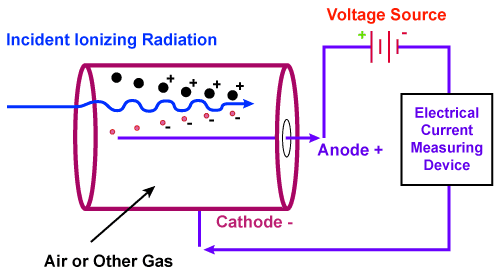The ionization chamber is used for detecting nuclear radiations. It is similar to Geiger Muller Tube as we discussed in the previous article. There is also another type of radiation detector i.e. scintillation counter that we have discussed in another article.
The ionization chamber consists of a metal cylinder (acts as a cathode) sealed at one end by a window. The other end is closed and a rod is inserted in the middle of the cylinder. This rod acts as an anode.
The chamber contains a gas which may be nitrogen, carbon dioxide, air, etc. The anode is connected to the voltage source and an electrical current measuring device (Electrometer).
The main use of this chamber is to detect and measure the alpha particles.

Working of Ionization chamber
- Consider fig1. having chamber filled with air.
- When a nuclear radiation enters the chamber through the window, some of the atoms of air are ionized.
- Ionizations creates positive and negatives ions.
- Positive ions go towards the cathode and negative ions towards the anode.
- Due to movement, these ions collide with other gas atoms causing ionization.
- The movement of ions causes current to flow.
- This current flow through the electrical current measuring device (Electrometer).
- An electrometer then counts the number of total charges Q.
- Charge Q is proportional to the radiation particles that have entered the chamber.
- The intensity of the nuclear radiation may be determined.

Great site. Cheers for posting.